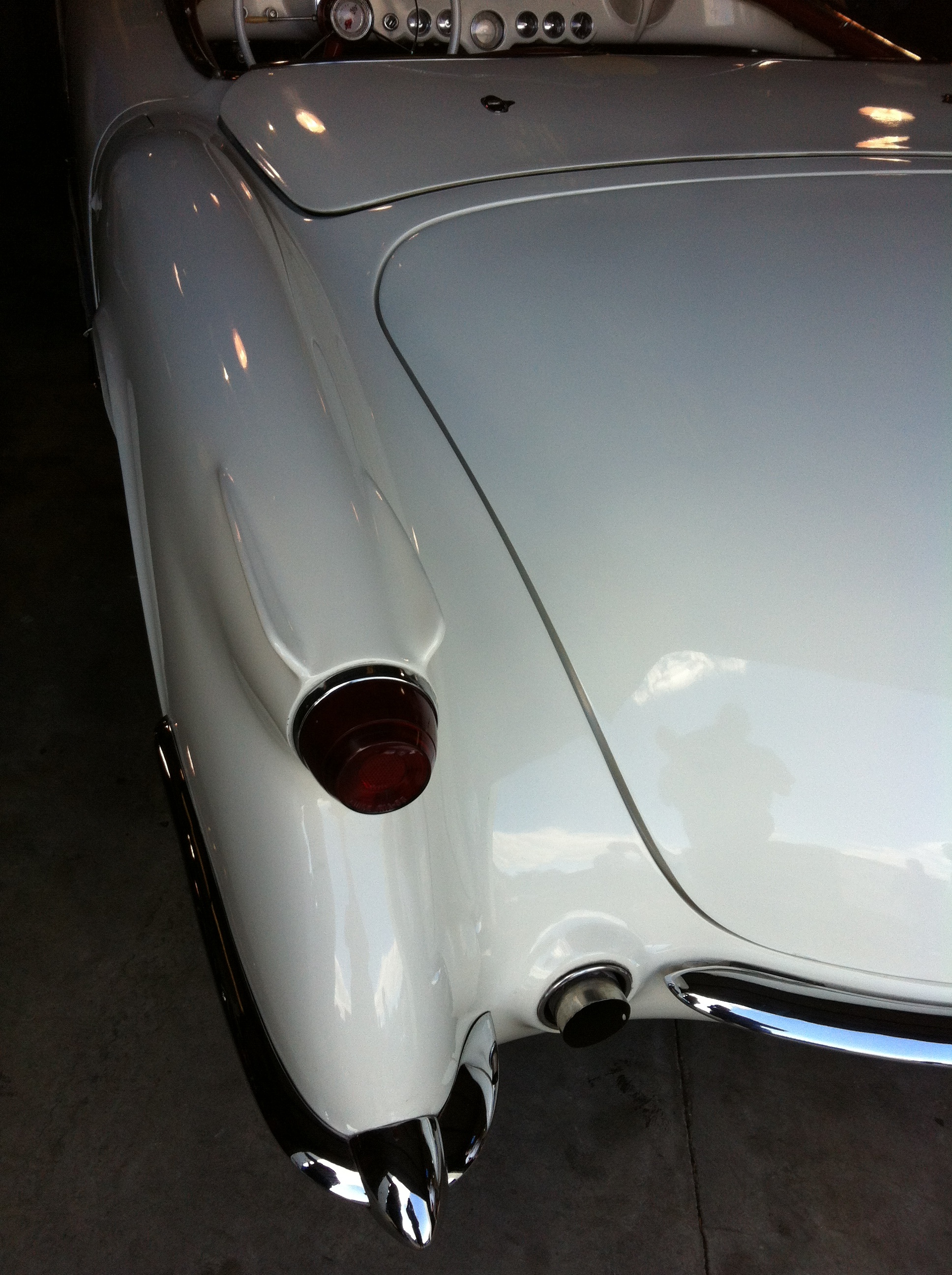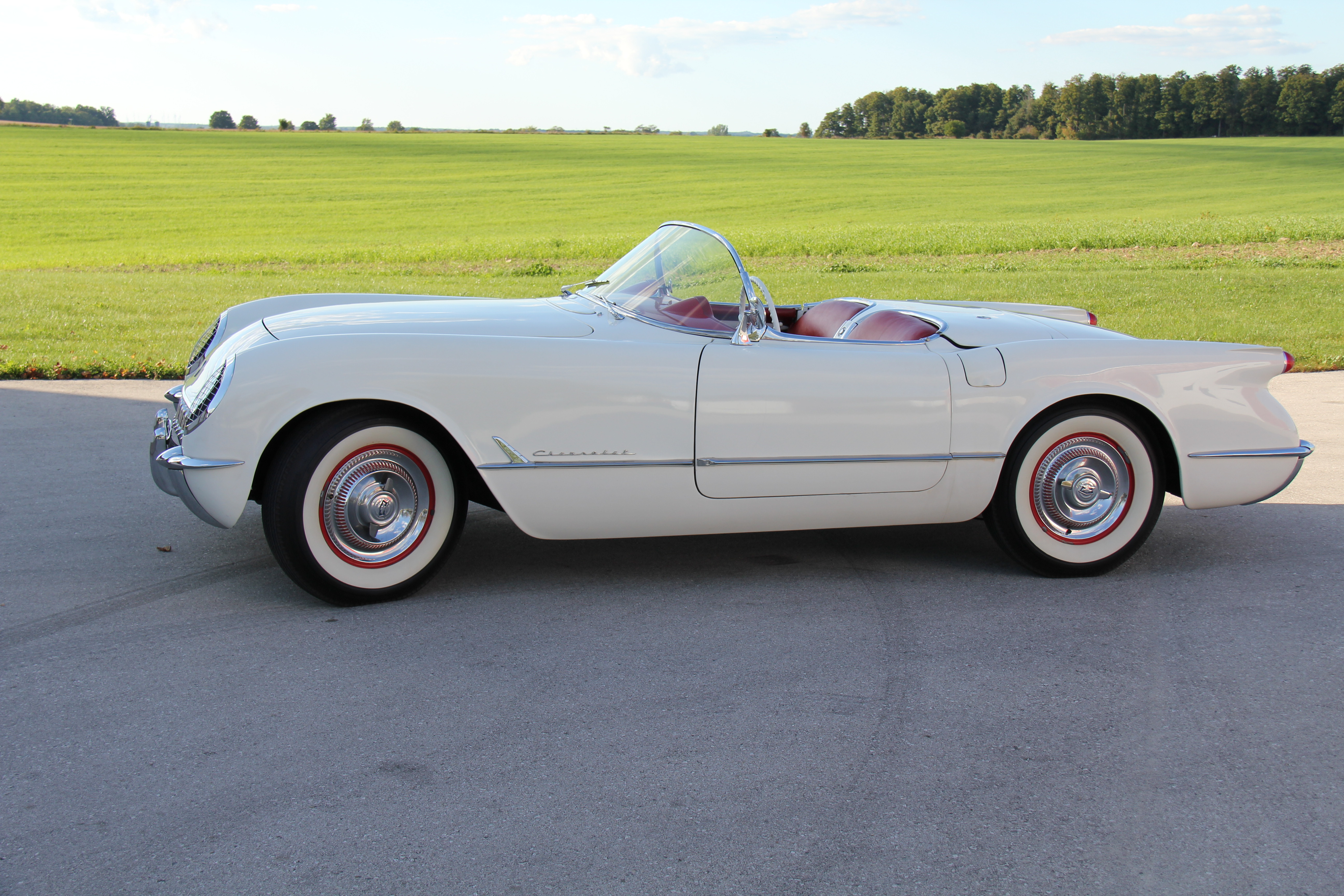1954 WHITE CORVETTE NO 15
Harley Earl, GM’s Legendary Designer, accomplished two things when he put his vision of an affordable American sports car before the public at Motorama in New York in 1953. First he fired people’s imagination enough to convince GM to hard-build 300 proof-of-concept cars for sale by late 1953. Like this example, the 1953 Corvette was only available in Polo White with red interior.
The second thing that the 1953 Motorama Corvette accomplished was to bring Zora Arkus-Duntov into the fold to bring increased performance to the Corvette over the years. He was one of the leading voices in developing the legendary small block V-8 for Chevrolet (and Corvette) in 1955 and even larger engines and more horsepower to power Corvettes in the coming years.
This 1954 Corvette is powered by Chevrolet’s 235/150 HP Blue Flame Six engine with three Carter side-draft carburetors using chromed dual pot air cleaners. The 1954 Corvettes were built on the line at a newly renovated facility located in St. Louis, Missouri. A total of 3,640 vehicles were made that first year but only about 600 were sold. Chevrolet Dealers was finally able to unload the rest of them in 1955 although it proved to be very difficult.
The 235 cubic inch six-cylinder was modified during the middle of 1954. A camshaft change increased horsepower to 155. Also, three new exterior colors were offered: Pennant Blue, Sportsman Red, and Black. A beige interior was also introduced. Production that year was made up of 4 black, 100 red, 300 blue, and 3,230 white vehicles.
The base price of the 1954 Corvette was $2,774.00 which was over $500 less than then the 1953 model. This was made possible in part because the vehicle was produced on an assembly line and not hand-built like the 1953 model.
GM: The Engineers
Late in 1910 Carl Fisher, owner of the Indianapolis Speedway and America’s largest supplier of kerosene lights and related fixtures for the rapidly growing automobile market, looked out from his office at the lights of a lone car going round and round the Speedway and asked his assistant who that was and what were they doing? The answer came back that it was a gentleman from Dayton OH named Kettering. When asked what this Kettering was doing, the answer came back, “Mr. Fisher, you rented your track to the man who is going to put you out of business!”
And indeed it was to be for at that moment Charles Kettering was testing a generator system to power electrical lights for cars. In just a few short years there would not be any kerosene lit new cars sold in North America. So who was Charles Kettering?
Born in 1876, “Boss” Ket was an inventor who spearheaded many of the innovations that were integral to the success of the automobile we know today. His motto: “The harder I work, the luckier I seem to get” encapsulates his approach to life. His first job at National Cash Register (NCR) in Dayton saw him invent the electric cash register. While at NCR he also met his life long partner in Edward Deeds. Together they started Dayton Engineering Labs (Delco) and developed generator based electrical ignition systems for automobiles, the electric self-starter, and lighting. After Delco was absorbed by GM, Kettering started GM Research Laboratories which in 1925 was moved to Detroit.
During his time at GM Labs, Kettering contributed to the growth of the industry by innovating such products as ethyl gasoline for high compression engines, crankcase ventilation, balancing machines, Freon for electric air-conditioning (for cars and houses), the two-cycle diesel locomotive engine that spelled the end of steam trains the world over and led a team to fine tune the automatic transmission (GM Publications).
But long time GM President Alfred P. Sloan said that `Boss Ket’s” greatest contribution to GM’s over-whelming success was the invention of the DUCO paint process of allowing GM to distance themselves from Henry Ford’s “any color you want as long as it was black.” Now, when you bought a GM car, you could choose from a range of colors!’
Toward the end of his career at GM, the Boss, along with another legend, Chief Designer Harley Earl, agitated for the development of a separate campus where all of the GM design and engineering labs and offices could be centrally located. As a result, the GM Tech Center was built in Warren MI where it remains to this day developing new designs and engineering breakthroughs for General Motors.
“`Boss Ket’ led the push for progress in the automotive industry. He believed that research should be a cooperative enterprise involving the integrated talents of all sorts of engineers and technicians . . . he functioned as a sort of spark plug, setting off one scientific explosion after another” (GM Biographies). His favorite saying was “it seems the harder I work, the luckier I get.”








